A Superlative Self-Made Chronograph From Self-Taught Independent Watchmaker Hajime Asaoka
The chronograph is making a comeback as the complication to create, which seems appropriate since it has always been an incredibly very difficult task to design and engineer a new chronograph movement.
A chronograph mechanism is extremely finicky and adjustment is a slow process. That is why many manufacturers tend to stay with tried and true movements instead of creating their own. It is much easier, not to mention cheaper, to use a movement or module that has been tried and tested for years in the real world than to stake huge amounts of capital on the development of something new.
Sadly, this means that the push for entirely new chronographs almost always comes from the biggest brands with large research and development budgets. Independent watchmakers tend to go after either entirely new complications or interesting implementations of basic complications rather than of developing an entirely new chronograph mechanics.
Luckily, though, times seem to be changing, and the ever-useful chronograph movement is getting some love again.
One of the newest contenders is a favorite among the independent watchmakers, self-taught Japanese horological virtuoso Hajime Asaoka.
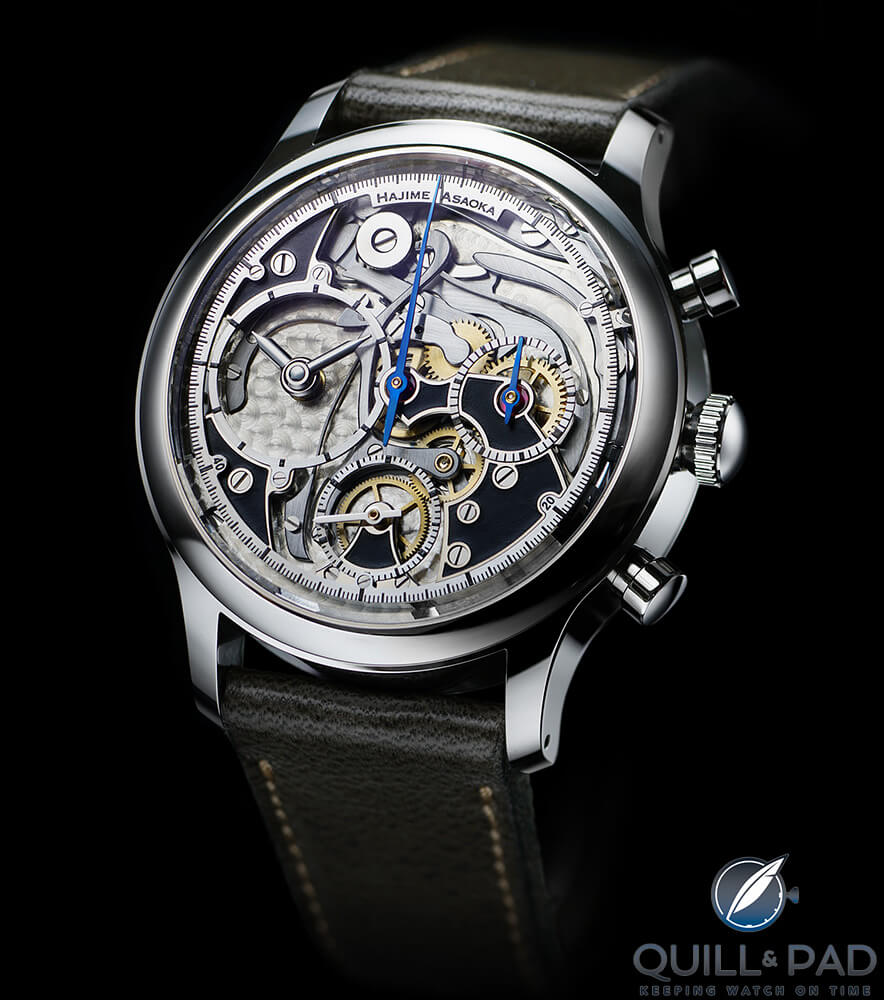
Hajime Asaoka Chronograph
After working for years developing multiple tourbillon movements as well as Tsunami, a time-only movement with a massive 16 mm balance wheel, Asaoka turned his sights on the beloved column wheel chronograph.
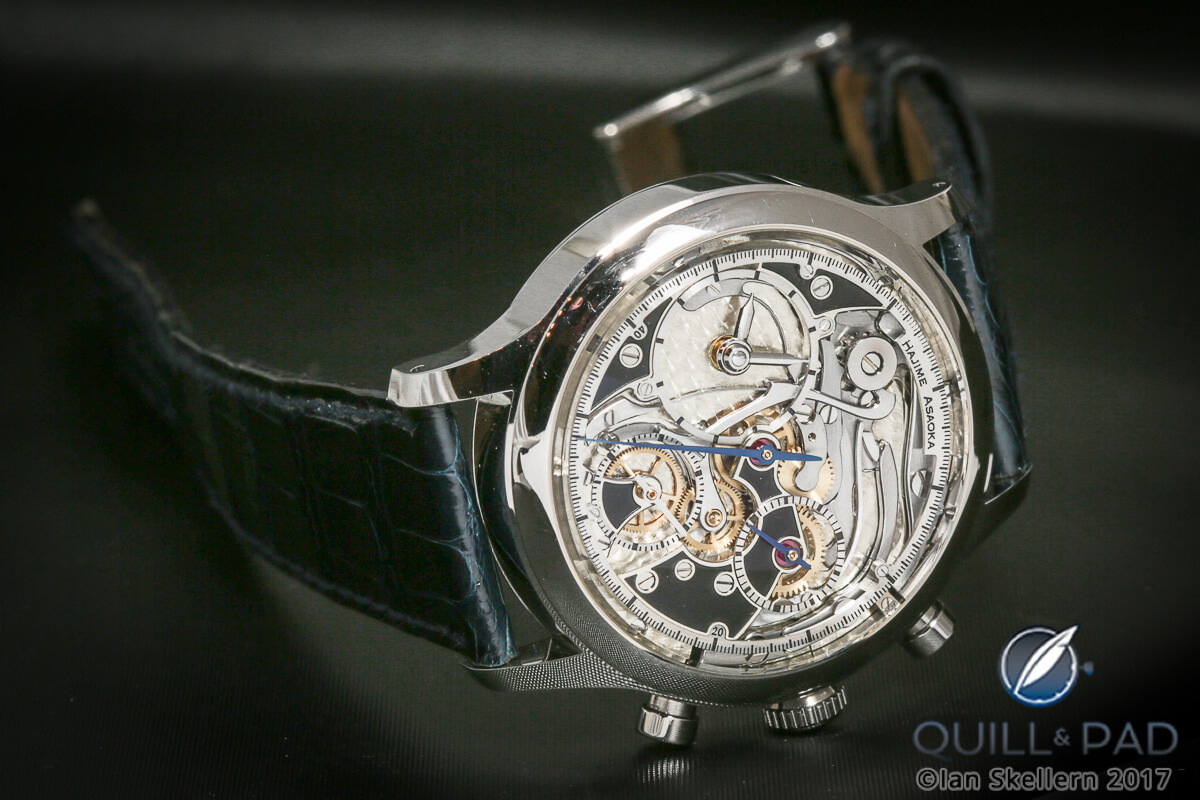
Hajime Asaoka Chronograph
His newest creation, appropriately named Chronograph, is based on the Tsunami movement with its oversized balance wheel. While the base movement is the same, but with the addition of the chronograph; much of the movement had to be redesigned for new hand locations and to make space for the chronograph mechanism.
Old and new
The Asaoka Chronograph is both an evolution of the Tsunami and a reaction to historic chronographs and some issues they had.
Asaoka wanted to place the chronograph mechanism on the dial side, less common as chronograph movements go, in an attempt to highlight its mechanics. He looked at old movements that used the same setup – such as the Venus 140 – and noticed a couple of key compromises that he wanted to correct.
First, a running seconds display was omitted on the Venus 140, a feature that Asaoka desired on his chronograph. Also, many watches powered by the Venus were monopusher chronographs; Asaoka preferred two pushers.
He wanted to make a very classically sized two-button chronograph with a very intricate mechanism visible for all WIS to enjoy. The result delivers that and exceeds my expectations for what an Asaoka chronograph would be.
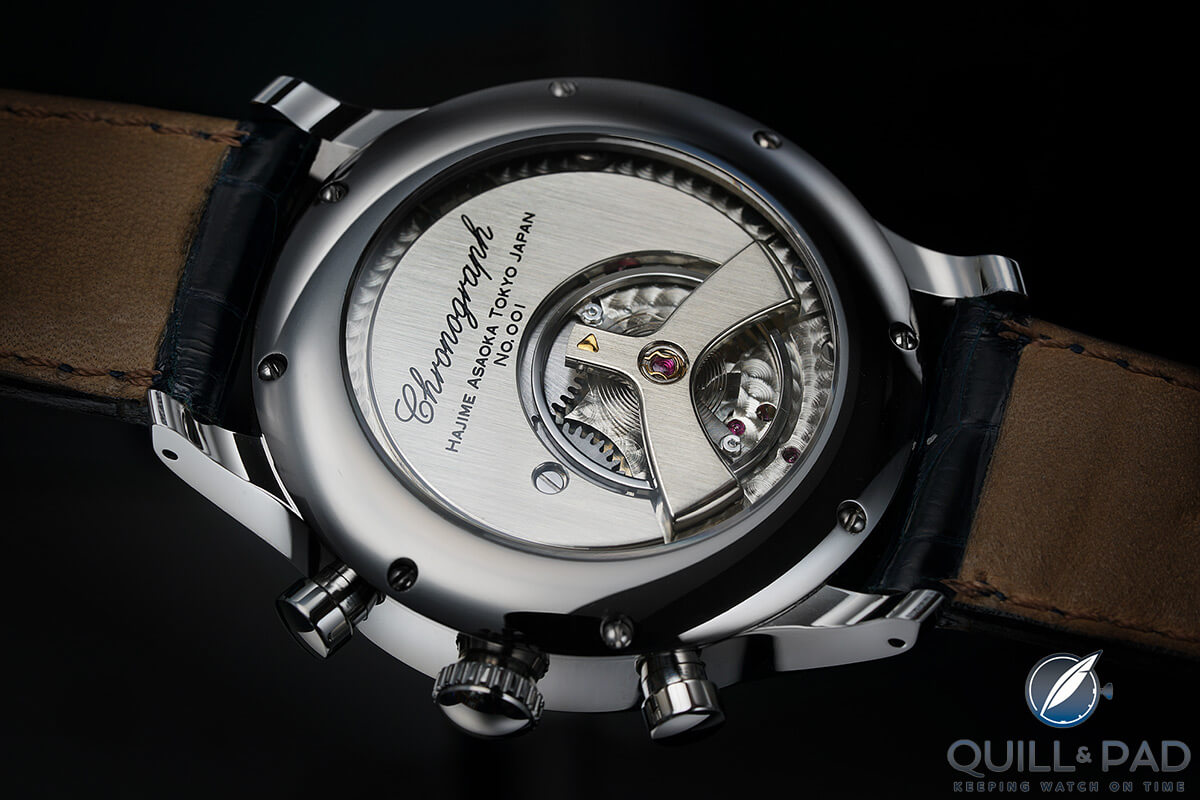
View through the display back of the Hajime Asaoka Chronograph
Through the display back you can see that the balance is situated above the movement with no distractions as the gearing for the going train is hidden underneath the back plate.
Since the time indication is off center, Asaoka needed to redesign the gear train architecture to fit with the new location for hours and minutes. He also had to develop the gearing for the running seconds at 6 o’clock, which is the driver for the chronograph mechanism.
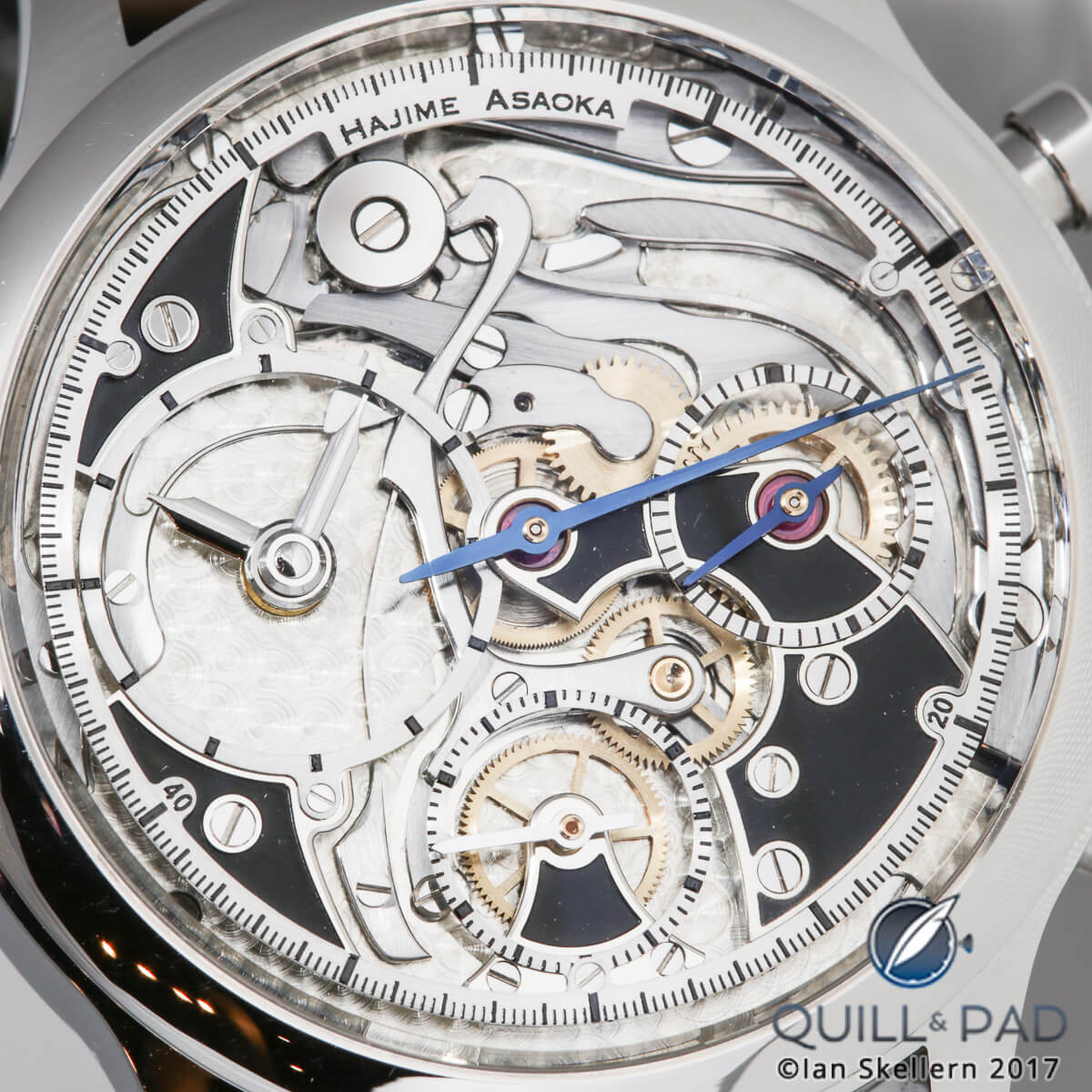
Close look dial side of the Hajime Asaoka Chronograph
As an aside, it seems that if the running seconds drives the chronograph mechanism, having a running seconds display is only logical and represents a missed opportunity for the historical inspiration.
Infused with mechanics
One of the major aspects of the original Tsunami movement was a very large spring barrel taking up a significant portion of the movement. This created challenges for Asaoka in designing around the “impenetrable” space smack dab in the middle of everything. This is why the very large balance is outside the movement on the rear and the gear train of the Tsunami is situated on the front of the movement.
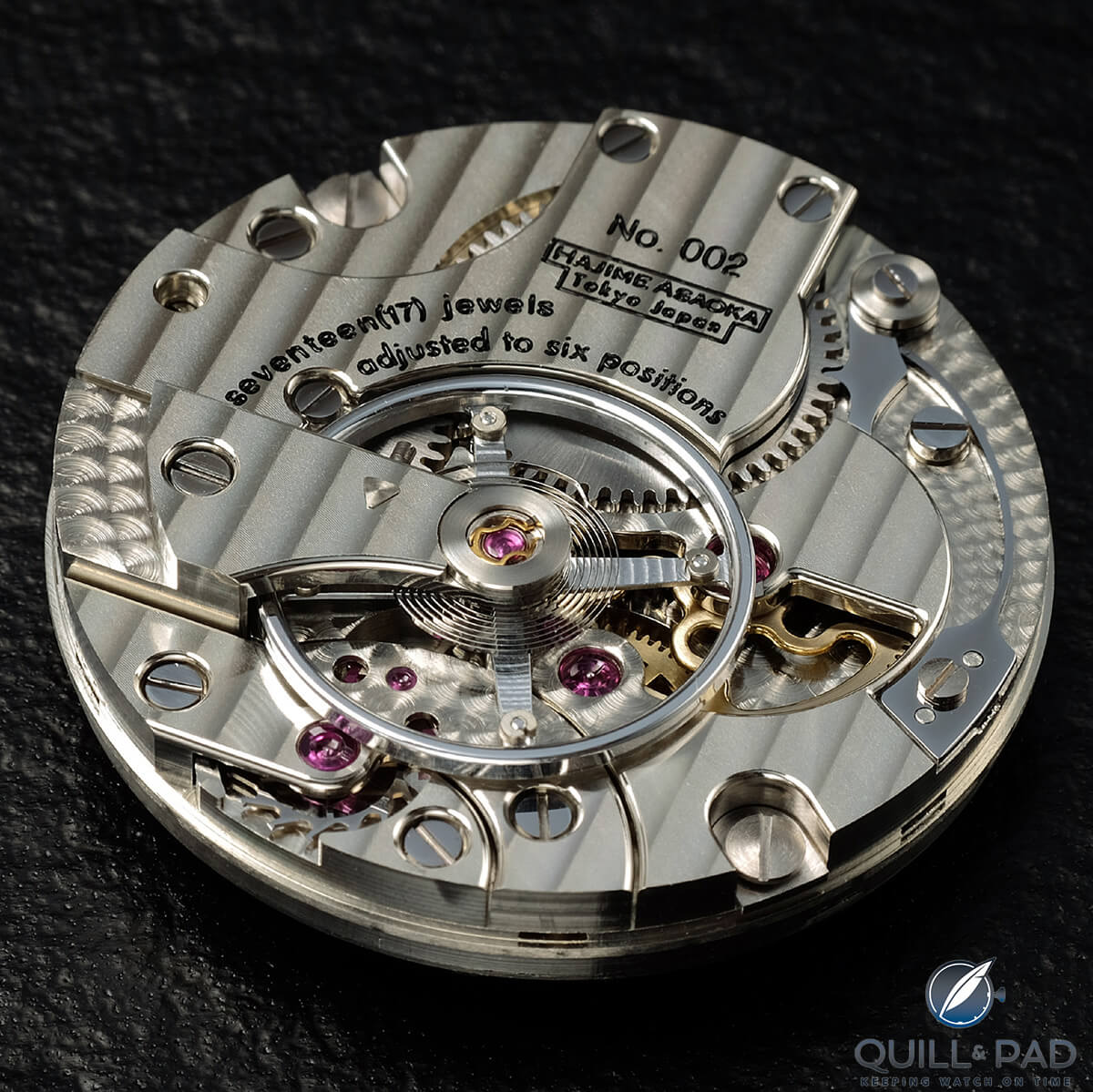
Hajime Asaoka Tsunami movement
But with the addition of a chronograph, moving the time indication off center allowed a bit of freedom for the gear train – that is, freedom to fit it around the chronograph mechanism. The entire mechanism takes up two-thirds of the dial with only two subdials showing the time, one of which – the running seconds – is also a part of the chronograph mechanism.
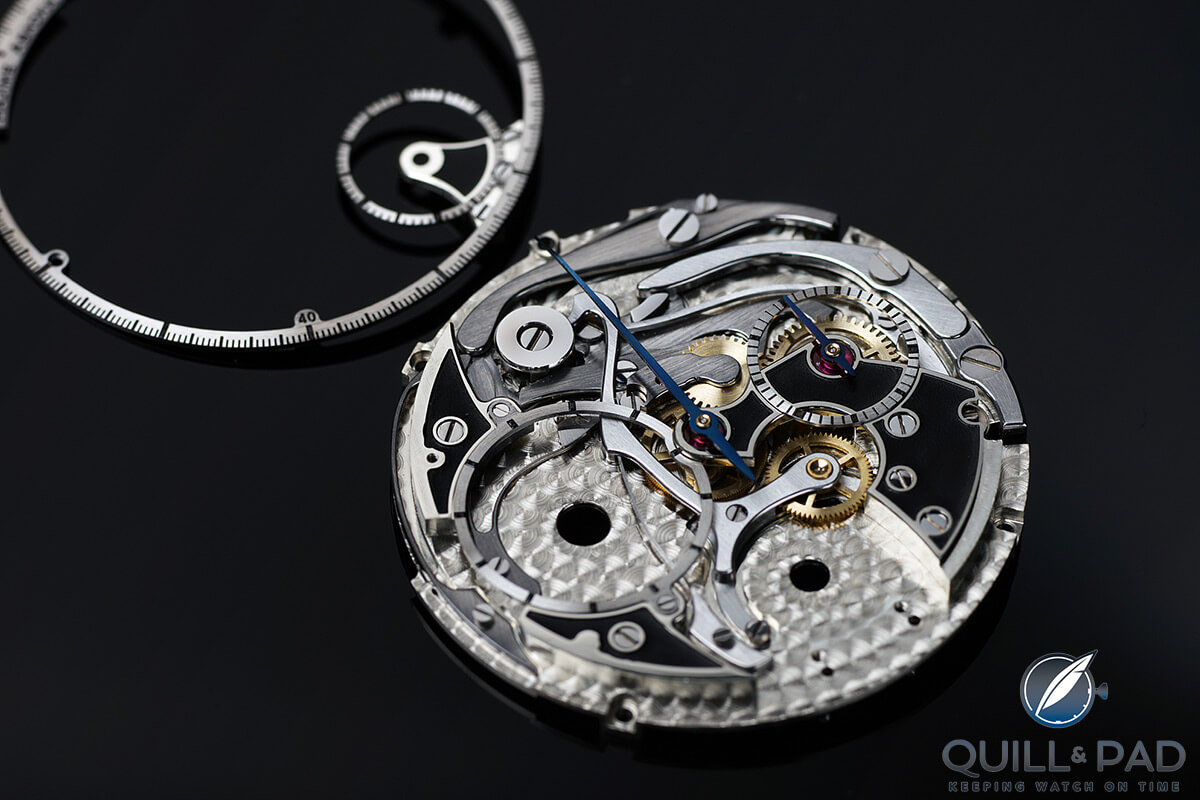
The chronograph mechanism above the main plate of the Hajime Asaoka Chronograph
There is one main bridge holding much of the chronograph gear train, while the levers, springs, and column wheel are mounted separately. The column wheel near 11:30 interacts with the carrying arm for the horizontal clutch, which pivots down near 6 o’clock on the other side of the dial.
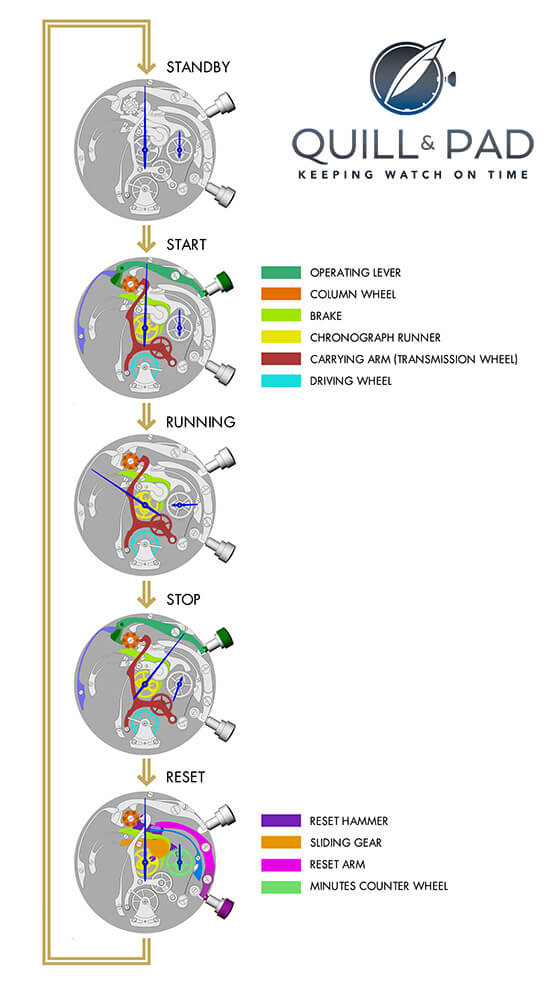
The handy color-coded breakdown shown above depicts how Asaoka’s mechanism works as it follows the chronograph function part by part through the movement.
This is a great bit of information to include with a new chronograph movement as it illustrates the design and engineering thinking that went into the movement as well as the overall attention to detail.
I know how different chronograph mechanisms work, yet this walk-through of the function is so good it seems like it should accompany every new mechanism and complication that any brand introduces.
Chronograph operation and details
The function is pretty straightforward for a twin-pusher column wheel chronograph, but to follow the function visually on the dial is a treat. Watching the clutch engage and disengage and seeing the reset arm snap the chronograph hands back to zero is mesmerizing – and exactly the reason Asaoka wanted the mechanism in full view dial side.
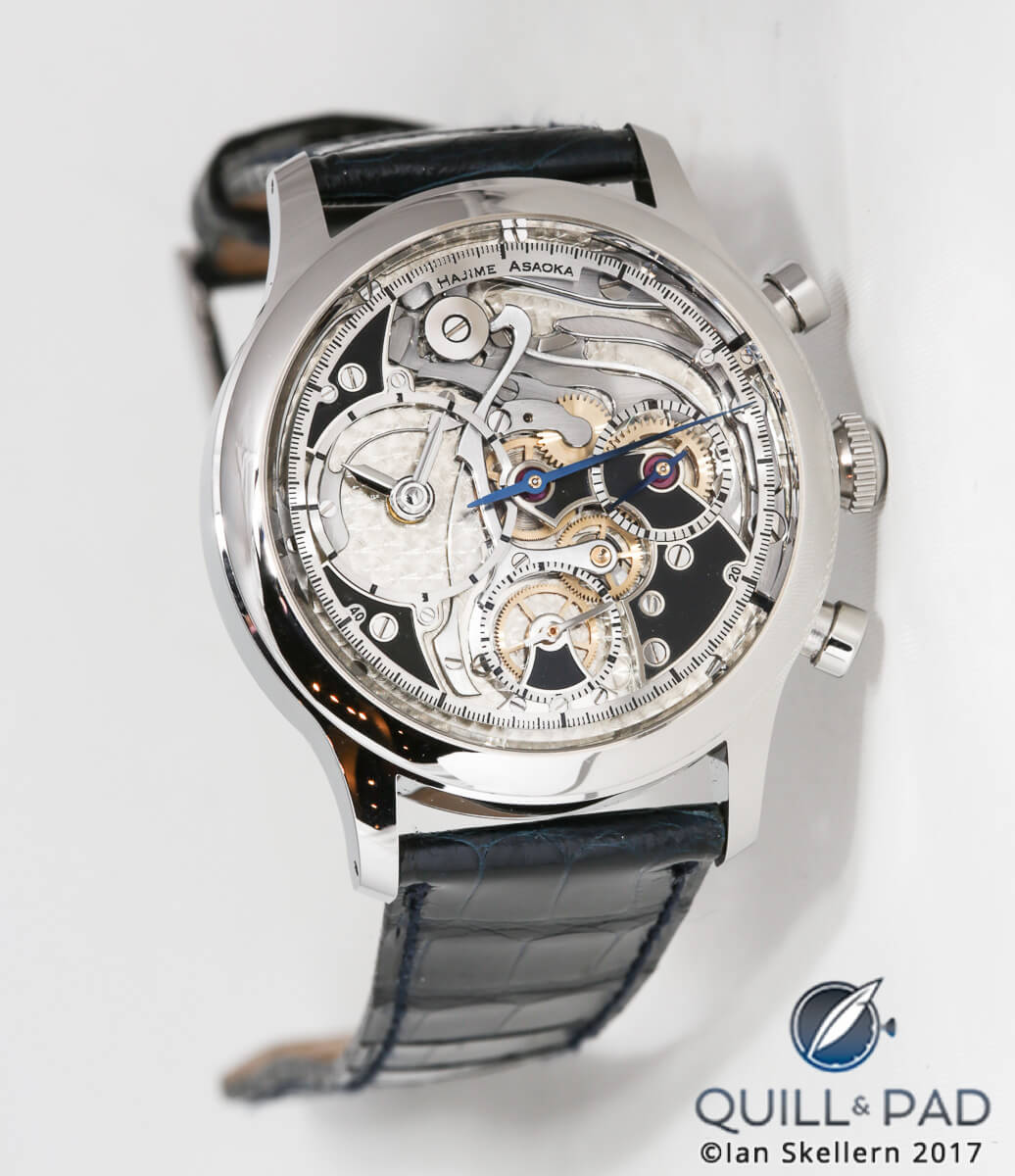
Hajime Asaoka Chronograph
He even made sure the minute counter was instantaneous instead of a running counter so that the action would be crisper, and the chronograph more legible.
Of course after all the hard work designing and fabricating the chronograph, the finishing on all the components needs to be excellent. And it is.
Asaoka favors round polished bevels instead of angled, giving the mechanism a much more vintage look. Most of the flat surfaces are straight-grained in different directions, with a few being flat polished. The contrast is kicked up a notch with four bridges having recessed surfaces that have been coated black.
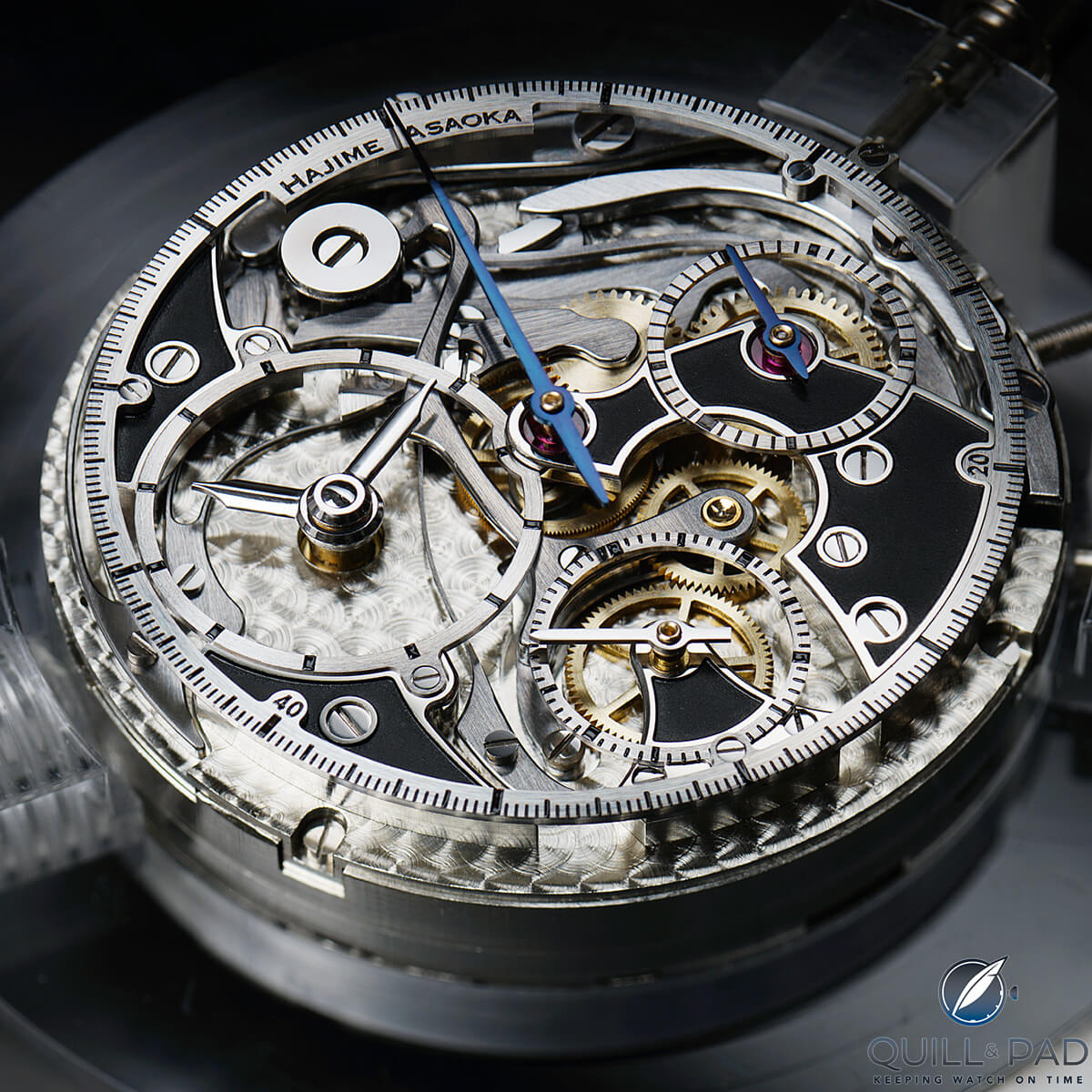
Uncased Hajime Asaoka Chronograph movement: note the beautifully sculptured hour and minute hands
The chronograph gear train is in brushed brass, which contrasts nicely with the steel components, while the chronograph hands are blued steel. The time indication hands are polished steel to visually separate the two functions.
The four dial/subdial rings are brushed steel with pad-printed markers, and even the machine used for this was designed and built by Asaoka.
The printing on every Hajime Asaoka dial is hand-stamped by the man himself, and he stamps multiple times to have a very thick, three-dimensional printing, differentiating his watches from mass-produced pieces.
The rear of the movement is fantastically simple, with the balance wheel presented under a fantastic tri-lobe bridge standing proudly from the back plate. The look of this movement from the rear differs significantly from its Tsunami predecessor, which appeared like a more traditionally constructed movement (with the exception of that mesmerizing, large balance).
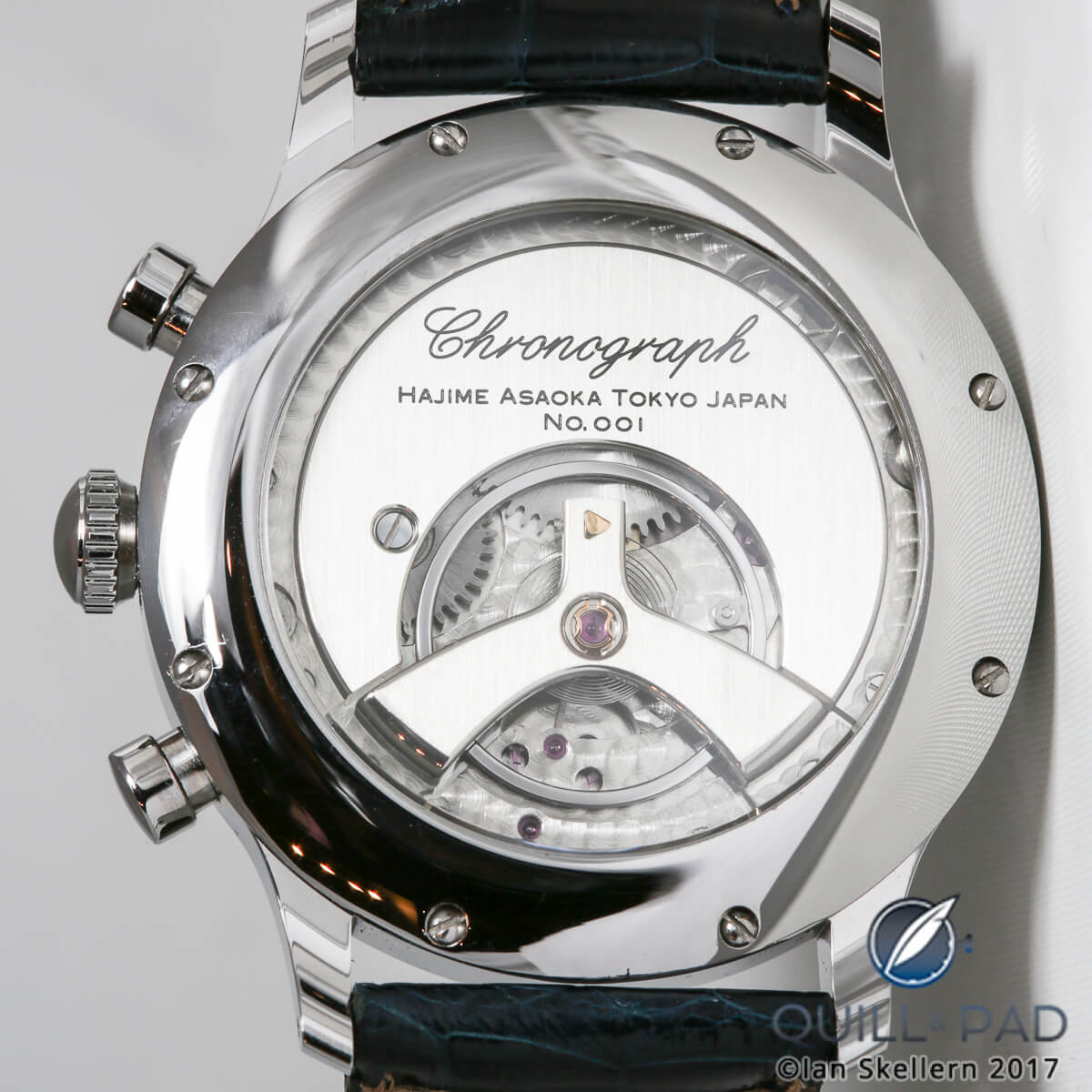
View through the display back of the Hajime Asaoka Chronograph
The Chronograph features an intensely sharp reduction in features and a quest for absolute symmetry, which is almost accomplished if it weren’t for a single screw head on one side. Still, the tidiness of the rear of that movement is something that tickles the back of my brain and has me asking for more.
Best parts
For many watch enthusiasts, especially those who love vintage timepieces, this watch will be sure to spark interest. It is entirely modern, but there is certainly a touch of vintage timepiece je ne sais quoi in there too.
The smallish 38 mm case size fits perfectly with a vintage collection, and the exposed mechanics don’t feel overly modern either.
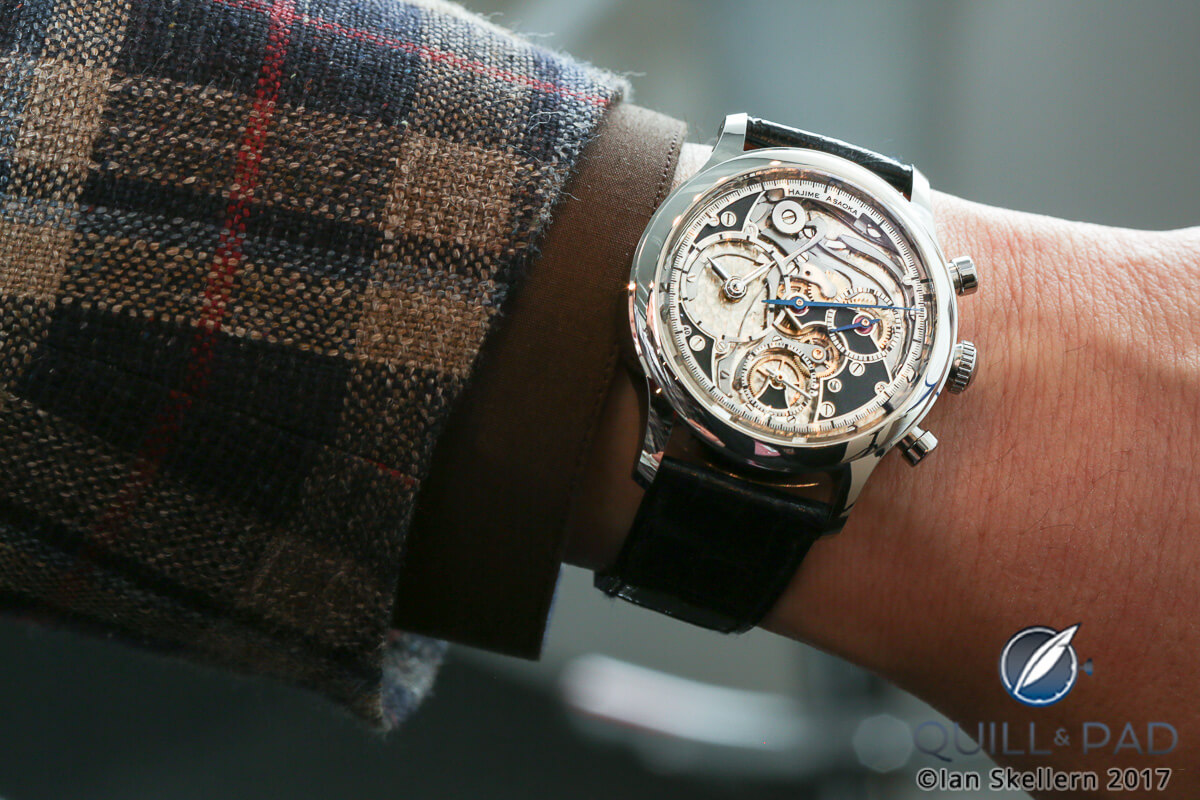
Hajime Asaoka Chronograph on the wrist of its creator
After the incredible mechanics of a brand-new chronograph and soupçon of a vintage-inspired modern watch, one of the best parts of this watch is Hajime Asaoka himself.
If you follow Asaoka on Facebook, Twitter, or Instagram (or, even better, all three), you also have the ability to track the design and construction of his next projects and see the way he works. I had watched the development of the Chronograph for a while before finally seeing it at Baselworld.
The ability to get nearly live updates from an independent watchmaker is great, and Asaoka is a leader at showcasing what he is working on next. It really goes hand in hand with his self-taught nature; sharing projects with friends is the only logical thing to do.
And thanks to the internet and Google Translate, you can be his friend too.
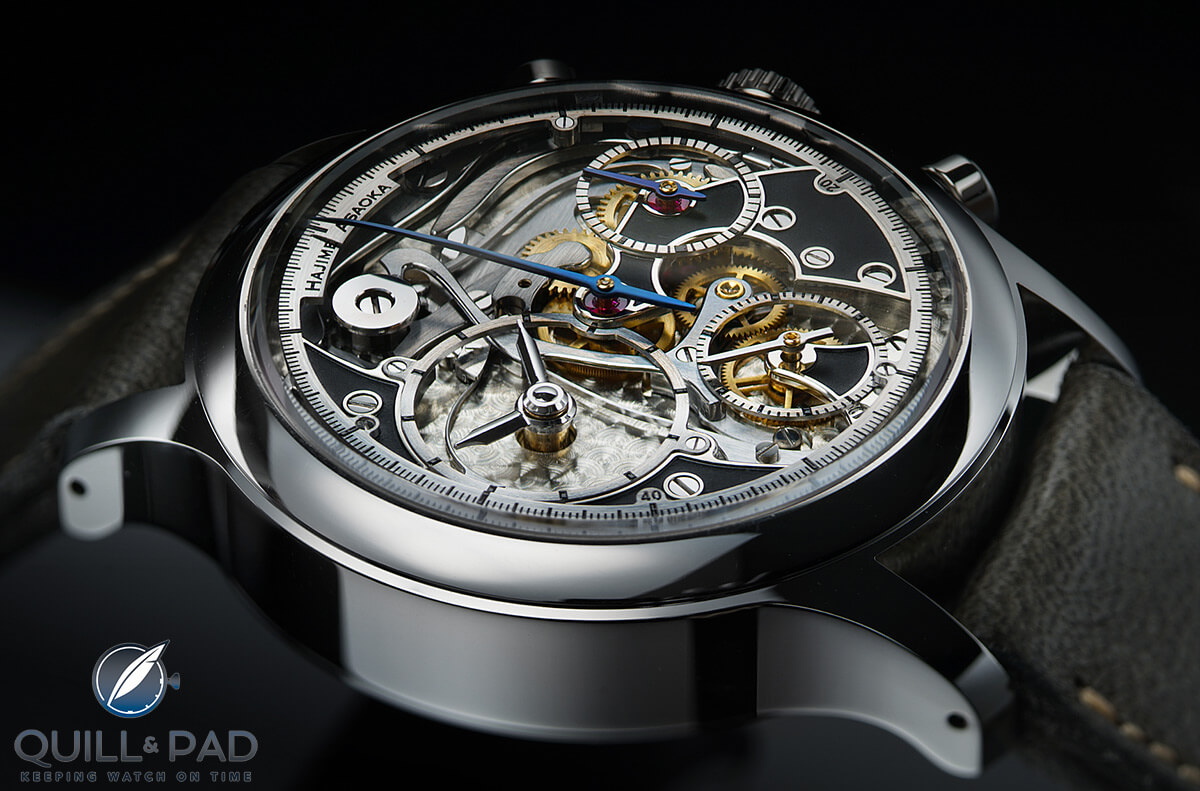
Hajime Asaoka Chronograph
I truly loved seeing this watch and getting the opportunity to put it on and try it out. But I loved even more knowing the process and the hard work that went into it.
Big brands talk a lot about the hard work they put into their products, but very few actually show it. It is awesome to see the development of a new caliber through the posts of an independent; it really is what makes it fun in the modern age.
And with an esoteric industry like mechanical watches, there is always more room for fun.
And to continue the fun, the breakdown!
- Wowza Factor * 9.7654 Self-taught independent watchmaker designs and creates new chronograph movement. Once you know how hard that is, the wows keep coming!
- Late Night Lust Appeal * 92.2 » 904.173 m/s2 Independent watchmakers don’t need much to keep me lusting well into the night, but this one definitely packs quite a punch!
- M.G.R. * 68.8 Do I really need to justify why this movement is ridiculously awesome!?
- Added-Functionitis * Moderate Adding a chronograph is a pretty impressive feat for an independent watchmaker. Yet it only counts as one function, however useful it is. That means regular strength Gotta-HAVE-That cream should do you just fine!
- Ouch Outline * 11.2 Hot welding slag falling in your boot! Not fun, not by a long shot. While it doesn’t happen too often, nobody wants to do it again. But if this was offered in exchange, I would have a tough time turning it down to get the Asaoka Chronograph on my wrist!
- Mermaid Moment * 61 seconds! All I need to see is one revolution of the chronograph with the activation of the instantaneous minute counter and I will be booking a DJ faster than you can say, “start!”
- Awesome Total * 945 Multiply the diameter of the balance wheel in mm (15) with the number of jewels in the movement (21) and multiply that by the number of pieces (3) to lead to one independently awesome total!
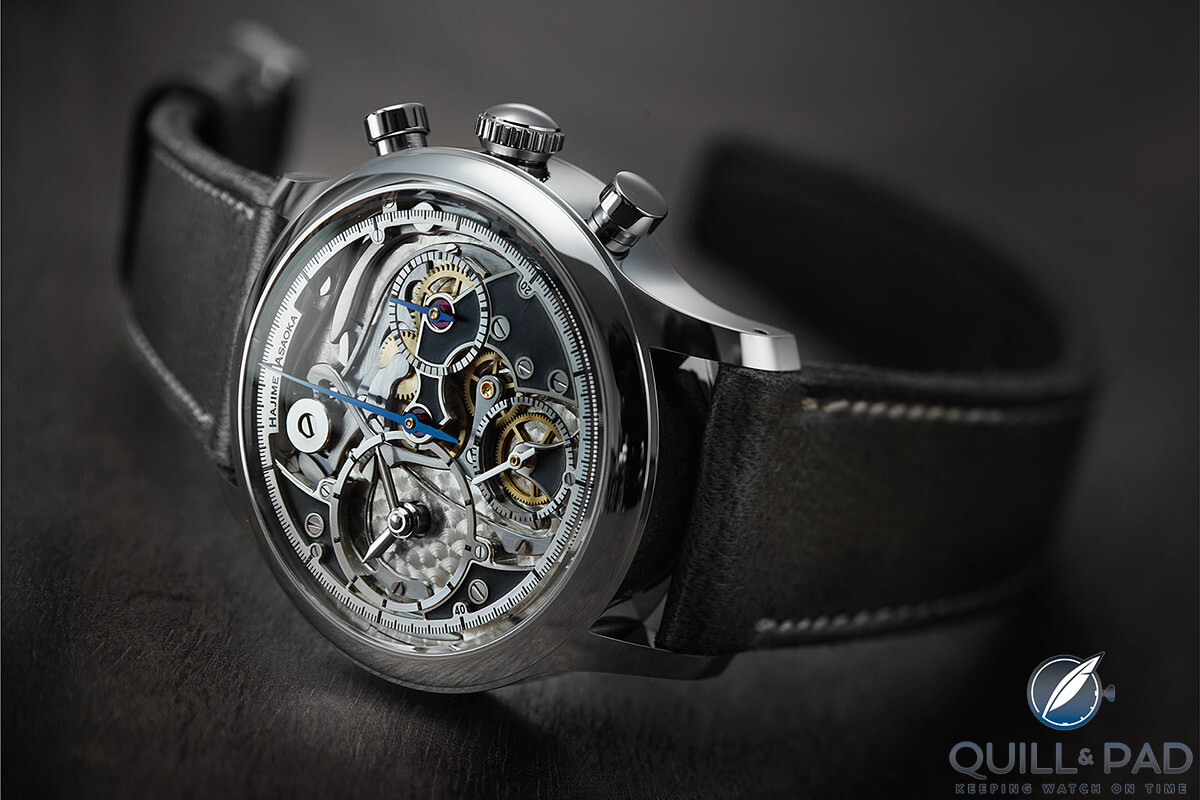
Hajime Asaoka Chronograph
For more information, please visit Hajime Asaoka on his social media accounts at
www.instagram.com/hajime_asaoka
Tweets by HajimeAsaoka
www.facebook.com/hajime.asaoka
Quick Facts Hajime Asaoka Chronograph
Case: 38 mm, stainless steel
Movement: manually winding Hajime Asaoka Chronograph caliber
Functions: hours, minutes, seconds; chronograph with minute counter
Limitation: 3 pieces
Price: ¥12,000,000 (approx. $107,600)
Leave a Reply
Want to join the discussion?Feel free to contribute!



“Self-Made Chronograph”? First time I see a chronograph made by itself…
Be serious!!
It’s a bit difficult for these older eyes to visualize what I need out of a time piece but I think it’s still a piece of engineering marvel, especially in light of the notion that the watchmaker is self-taught!
That said, Luciano, thank you for your absolutely brilliant assessment of the watch!
For a moment, I thought I’d stumbled onto a grammar site as opposed to a watch site!
By the way, I think you were meaning to say, “Self-made Chronograph? First time I’ve seen a chronograph make itself…”
A lot of good stuff there – and not even at an insane price (even if well beyond my bank-manager’s discretionary generosity) – still, it’s a shame that the dial-side has ended up looking like a dog’s dinner!
This is what I might call an inside-out watch. There is practically no dial so I can assume that the mechanical interactions are the star of the design. This makes me think that actual chronograph usage is not the mission of this watch, but maybe a celebration of gears and finishing techniques. I am afraid that many of us might not get the mechanical cleverness put into the movement… it might be over our heads and the designer might not be talking to us. It seems to have a split personality too… the back is ultra clean and the front is the opposite. Overall, an intriguing artist’s vision in metal.
I think he was exhausted after this creation, had no energy left to make “The Dial” for his first chronograph ?
Also the tremendous urge to have his years of work and planning as the star of the show,made the no dial as the dial decision for him. IMO